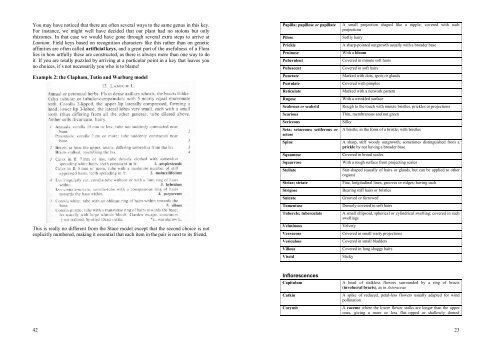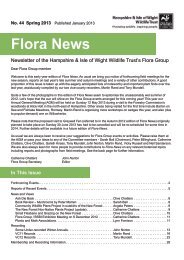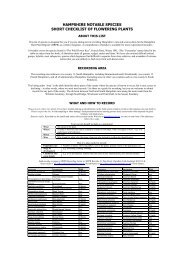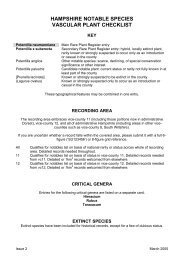An A5 booklet version as distributed in the - Hants Plants
An A5 booklet version as distributed in the - Hants Plants
An A5 booklet version as distributed in the - Hants Plants
You also want an ePaper? Increase the reach of your titles
YUMPU automatically turns print PDFs into web optimized ePapers that Google loves.
You may have noticed that <strong>the</strong>re are often several ways to <strong>the</strong> same genus <strong>in</strong> this key.<br />
For <strong>in</strong>stance, we might well have decided that our plant had no stolons but only<br />
rhizomes. In that c<strong>as</strong>e we would have gone through several extra steps to arrive at<br />
Lamium. Field keys b<strong>as</strong>ed on recognition characters like this ra<strong>the</strong>r than on genetic<br />
aff<strong>in</strong>ities are often called artificial keys, and a great part of <strong>the</strong> usefulness of a Flora<br />
lies <strong>in</strong> how artfully <strong>the</strong>se are constructed, <strong>as</strong> <strong>the</strong>re is always more than one way to do<br />
it. If you are totally puzzled by arriv<strong>in</strong>g at a particular po<strong>in</strong>t <strong>in</strong> a key that leaves you<br />
no choices, it’s not necessarily you who is to blame!<br />
Example 2: <strong>the</strong> Clapham, Tut<strong>in</strong> and Warburg model<br />
This is really no different from <strong>the</strong> Stace model except that <strong>the</strong> second choice is not<br />
explicitly numbered, mak<strong>in</strong>g it essential that each item <strong>in</strong> <strong>the</strong> pair is next to its friend.<br />
42<br />
Papilla; papillose or papillate A small projection shaped like a nipple; covered with such<br />
projections<br />
Pilose Softly hairy<br />
Prickle A sharp-po<strong>in</strong>ted outgrowth usually with a broader b<strong>as</strong>e<br />
Pru<strong>in</strong>ose With a bloom<br />
Puberulent Covered <strong>in</strong> m<strong>in</strong>ute soft haris<br />
Pubescent Covered <strong>in</strong> soft hairs<br />
Punctate Marked with dots, spots or glands<br />
Pustulate Covered with pimples<br />
Reticulate Marked with a network pattern<br />
Rugose With a wr<strong>in</strong>kled surface<br />
Scabrous or scabrid Rough to <strong>the</strong> touch with m<strong>in</strong>ute bristles, prickles or projections<br />
Scarious Th<strong>in</strong>, membranous and not green<br />
Sericeous Silky<br />
Seta; setaceous; setiferous or<br />
setose<br />
A bristle; <strong>in</strong> <strong>the</strong> form of a bristle; with bristles<br />
Sp<strong>in</strong>e A sharp, stiff woody outgrowth; sometimes dist<strong>in</strong>guished from a<br />
prickle by not hav<strong>in</strong>g a broader b<strong>as</strong>e<br />
Squamose Covered <strong>in</strong> broad scales<br />
Squarrose With a rough surface from project<strong>in</strong>g scales<br />
Stellate Star-shaped (usually of hairs or glands, but can be applied to o<strong>the</strong>r<br />
organs)<br />
Striae; striate F<strong>in</strong>e, longitud<strong>in</strong>al l<strong>in</strong>es, grooves or ridges; hav<strong>in</strong>g such<br />
Strigose Bear<strong>in</strong>g stiff hairs or bristles<br />
Sulcate Grooved or furrowed<br />
Tomentose Densely covered <strong>in</strong> soft hairs<br />
Tubercle; tuberculate A small ellipsoid, spherical or cyl<strong>in</strong>drical swell<strong>in</strong>g; covered <strong>in</strong> such<br />
swell<strong>in</strong>gs<br />
Velut<strong>in</strong>ous Velvety<br />
Verrucose Covered <strong>in</strong> small warty projections<br />
Vesiculose Covered <strong>in</strong> small bladders<br />
Villous Covered <strong>in</strong> long shaggy hairs<br />
Viscid Sticky<br />
Inflorescences<br />
Capitulum A head of stalkless flowers surrounded by a r<strong>in</strong>g of bracts<br />
(<strong>in</strong>volucral bracts), <strong>as</strong> <strong>in</strong> Asteraceae<br />
Catk<strong>in</strong> A spike of reduced, petal-less flowers usually adapted for w<strong>in</strong>d<br />
poll<strong>in</strong>ation<br />
Corymb A raceme where <strong>the</strong> lower flower stalks are longer than <strong>the</strong> upper<br />
ones, giv<strong>in</strong>g a more or less flat-topped or shallowly domed<br />
23







